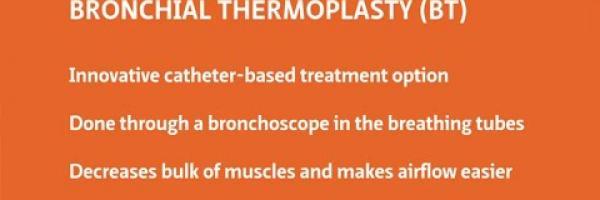Bronchial Thermoplasty FAQ
Skip
What causes shortness of breath and breathing difficulties in people with asthma?
People with asthma have more smooth muscle surrounding their airways. This excess muscle, combined with swelling of the airways, makes the airways narrower than normal. When an irritant enters the airway, it causes the muscles to constrict, which blocks the airflow and causes shortness of breath.
How does bronchial thermoplasty work?
The conventional treatment for severe asthma is to reduce swelling in the airways with inhaled medication (inhalants). Bronchial thermoplasty uses radiofrequency energy (heat) to reduce the smooth muscle of the breathing tubes to open up airways and improve breathing.
Approved by the U.S. Food & Drug Administration in 2010, bronchial thermoplasty clinical trial results showed the procedure can help improve symptoms and reduce the number of severe asthma attacks.
Who’s eligible for this treatment?
Bronchial thermoplasty could be an option for you if you’re:
- Diagnosed with severe or persistent asthma that doesn’t respond to inhaled corticosteroids or long-acting bronchodilator medications.
- Between 18 and 65 years old.
- A nonsmoker for at least the past year.
People with asthma who have a pacemaker, internal defibrillator or other implantable electronic device aren’t candidates for bronchial thermoplasty. It’s also not an option for anyone who has sensitivities to lidocaine, atropine or benzodiazepines — medications necessary to perform bronchoscopies.
How is bronchial thermoplasty performed?
This outpatient bronchoscopy procedure is performed in three treatment sessions, scheduled approximately three weeks apart, with each session focusing on a different section of the lungs.
To perform the procedure, your doctor threads a catheter (a small, flexible tube) through a bronchoscope — a device fitted with a light and a tiny camera — and uses radiofrequency energy to gently heat small sections of the airway, reducing the excessive smooth muscle.
The three treatment sessions include:
- First stage – Heat is applied to the muscles in one of the lower lobes of the lungs.
- Second stage – The procedure is repeated on the remaining lower lobe.
- Third stage – Heat is applied to the muscles in both upper lobes.
Lung function tests are performed before and after each stage to assess your response to treatment.
Is the procedure painful?
Bronchial thermoplasty is performed while you’re under anesthesia, so the procedure is painless. Most patients don’t experience pain afterward, but you may experience a mild sore throat due from the anesthesia.
What are the side effects of bronchial thermoplasty?
The most common side effect is a temporary worsening of respiratory-related symptoms, which typically occurs within a day of the procedure and resolves within a week. Other possible side effects could include a partially collapsed lung, coughing up blood, anxiety, headaches and nausea.
How long does each session take? Can I go back to work the next day?
Each session takes about 45 minutes, sometimes less. Plan on spending about half a day in the hospital for each treatment session. You can return to regular activities in 48 to 72 hours.
What do I need to know before my procedure, such as how to prepare and where to go?
You’ll follow the same guidelines as a bronchoscopy exam. However, your recovery time will be longer than for diagnostic bronchoscopy. You’ll remain in the recovery room for about four hours to assure you don’t experience asthma symptoms after the procedure.
